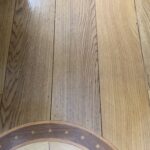
How the Wintertime and Summertime Effect Hardwood Floors
Have you ever wondered why your floors squeak? Ever wonder why your door sticks? The answer is related to the relative humidity. Most people who watch the local weather have received a lesson from meteorologists on this subject. Relative humidity pertains to how much water vapor is in the air. Most people are comfortable with a relative humidity level of 30-50 percent. When the dog days of summer are upon us the humidity creeps higher as shown on weather station charts.
Relative Humidity
Why all this talk of relative humidity? Because wood is a hygroscopic, meaning it is a material that absorbs and releases water. The warmer the air, the more moisture it can hold. Air in a home heated to 72 degrees can hold about 8 grains of moisture per cubic foot. That is 100% relative humidity. If there are only 2 grains per cubic foot in the home, this is ¼ of the air’s capacity to hold moisture. Therefore, the relative humidity is also ¼, or 25 %. The air could hold four times as much water.
The addition or reduction of moisture drastically affects the qualities, the dimensions, and the weight of hygroscopic materials. Wood, leather, paper, cloth, although they feel dry to the touch, contain water. Not a fixed amount of water but an amount that will vary greatly with the relative humidity level of the surrounding air. Take for example a cubic foot of wood with a bone-dry weight of 30lbs. At 60% relative humidity the wood holds over 3 pints of water. Now, if the relative humidity is lowered to 10%, the water held by the wood will not fill even one-pint measure. So, we have, in effect, withdrawn 2-1/2 pints of water from the wood by lowering the relative humidity from 60% to 10% (1 pint equals about 1lb.)
How does all this relate to your floors, simple. In the summer, your floors (or any hygroscopic material) will swell or expand during high relative humidity. Conversely in the winter your floors will shrink or dry out as the relative humidity is reduced.
Winter and Hardwood Floors
In the winter months when home heating systems are working overtime (at least in the New England area) hardwood floors will dry out and separate and you may notice squeaky floors. Noticing gaps in your floorboards is a common occurrence during extended dry spells. This is a normal occurrence.
Summer and Hardwood Floors
In the humid summer months hardwood floors tend to swell therefore making squeaks less noticeable. You may also notice your doors are not closing quite as easily and the gaps you noticed in your floorboards over the dry winter months have most likely closed. You may also experience slight cupping as the boards swell together.
Suggestions
Wood floors change with the humidity in the air. Here in New England, there will undoubtedly be some seasonal changes to your hardwood floors, but you can minimize this by using a humidifier in the dry winter months and a dehumidifier in the moist summer months. Or run an A/C in the summer months.

